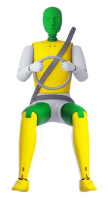Find more information in the General Comments section of the assessment
Find more information in the Rating Validity tab of the assessment
- See More
- See More
- See More
- See More
- Good
- Adequate
- Marginal
- Weak
- Poor
 Passenger
Passenger
 Driver
Driver
 Front Seat
Front Seat
 Car
Car
 Pole
Pole
- Good
- Adequate
- Marginal
- Weak
- Poor


Passenger
outboard
center
Fitted to the vehicle as standard
Not fitted to the test vehicle but available as option
Not Available
--childOccupantCommentEN--
- Good
- Adequate
- Marginal
- Weak
- Poor

Head Impact 9.2 Pts
Pelvis Impact 1.5 Pts
Leg Impact 6.0 Pts
The bonnet was rated as poor or marginal in most areas likely to be struck by a pedestrian's head. Similarly, the front edge of the bonnet did not provide good protection for pedestrians' legs. Only the bumper scored maximum points, offering good protection for pedestrians in all areas tested.
- Good
- Adequate
- Marginal
- Weak
- Poor
| Applies To | All seats | ||
| Warning | Driver Seat | Front Passenger(s) | Rear Passenger(s) |
| Visual | |||
| Audible | |||
|
|||
Electronic stability control is available as an option on the Picanto. However, its sales as standard equipment are not expected to meet Euro NCAP's 2011 requirements and the system was not assessed. A seatbelt reminder is standard equipment for the driver, front passenger and rear seats.
- Specifications
- Safety Equipment
- Videos
- Rating Validity
Specifications
Tested Model Kia Picanto 1.0 LX, LHD
Body Type - 5 door hatchback
Year Of Publication 2011
Kerb Weight 895kg
VIN From Which Rating Applies - applies to Picantos of the specification tested
Class City and Supermini
Safety Equipment
Note: Other equipment may be available on the vehicle but was not considered in the test year.
Fitted to the vehicle as standard
Fitted to the vehicle as option
Not fitted to the test vehicle but available as option
Not Available
Not Applicable
Videos
Rating Validity





Find more information in the General Comments section of the assessment
 Share
Share









The passenger compartment of the Picanto remained stable in the frontal impact. Dummy readings indicated good protection of the knees, femurs and pelvis of both the driver and front passenger. Kia demonstrated that a similar level of protection would be provided for occupants of different sizes and to those sat in different positions. Most body regions were well protected in the side barrier test, with adequate protection of the chest. However, the rear door on the struck side opened during the test and the car was penalised. In the more severe side pole test, the door remained fully latched. Dummy readings of rib deflection indicated marginal protection of the chest. The seat and head restraint provided marginal protection against whiplash injuries in the event of a rear-end collision.